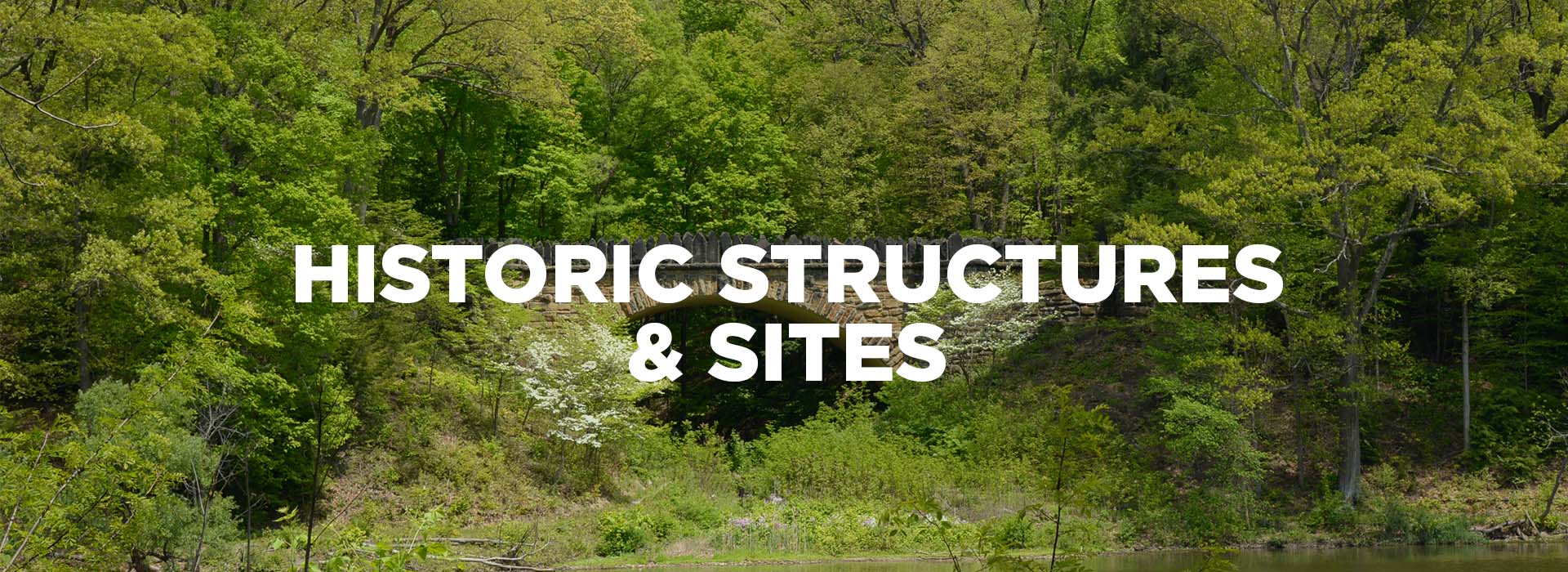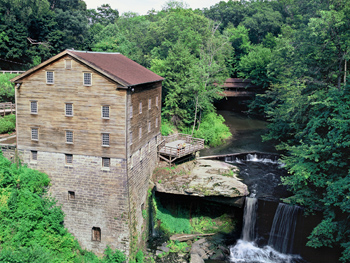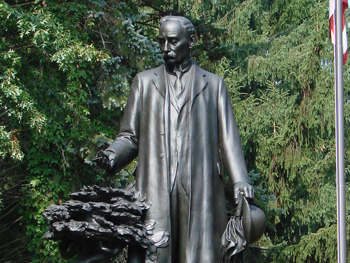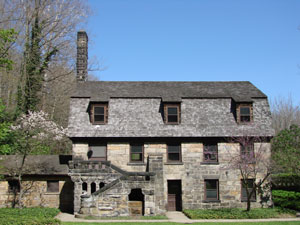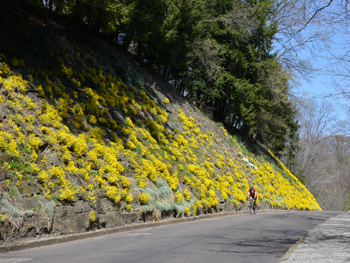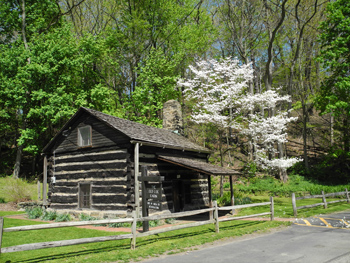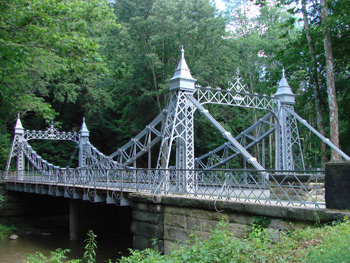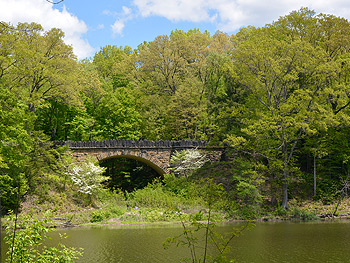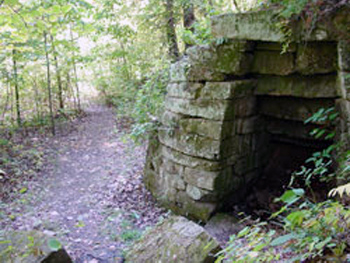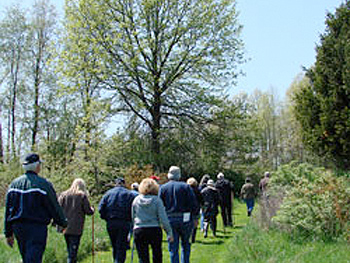Lanterman’s Mill
Lanterman’s Mill
One of Mahoning County’s most historic landmarks, Lanterman’s Mill was built in 1845 – 46 by German Lanterman and Samuel Kimberly. Restored in 1982 – 85 through a gift from the Ward and Florence Beecher Foundations, this community treasure represents one of the many pioneer industries developed along Mill Creek and operates today as it did in the 1800s, grinding corn, wheat, and buckwheat.
Volney Rogers Memorial
Dedicated in 1920, to the memory of Mill Creek Park founder Volney Rogers, this bronze statue was created by nationally renowned sculptor Frederick C. Hibbard. Funds for the memorial included donations from prominent citizens and Youngstown schoolchildren.
The eight foot bronze statue stands on a pedestal of red Missouri marble. The tree in the sculpture is a dwarf white thorn, a species selected by Volney for its tenacity. The motto on the base reads, “This park was conceived in his heart and realized through his devotion.”
Pioneer Pavilion and Mill Creek Furnace
Pioneer Pavilion
Pioneer Pavilion, located in Mill Creek Park, is one of the oldest structures in Youngstown, Ohio. Constructed in 1821, this sandstone building served as a mill for carding and fulling wool. The building was later used as a storeroom for the nearby Mill Creek Furnace, then remodeled for party use in 1893. In 1894, the woolen mill was officially named Pioneer Pavilion to honor its pioneer history. For many years it has been a popular place to hold family reunions, dances, parties and wedding receptions. Pioneer Pavilion is available for rent year-round.
The Mill Creek Furnace
Constructed in the late 1820s or early 1830s, the Mill Creek Furnace was the first blast furnace in Youngstown and the third in the Mahoning Valley built by members of the Heaton (Eaton) family, who were pioneer iron producers. They had built the Hopewell Furnace in Poland Township in 1803 and the Maria Furnace in Niles in 1813. Originally fueled by charcoal, the furnace with its thirty-foot stack, produced approximately three to four tons of iron each day. In the 1840′s, the Mill Creek Furnace was rebuilt to burn bituminous coal. The Mill Creek Furnace went out of blast in the late 1840s or early 1850s.
In April of 2003, more than 180 years after the closing of the Mill Creek Furnace, John R. White, Department of Sociology and Anthropology, Youngstown State University, led an archaelogical dig at the site. Today, visitors can view the remains of this historic structure, located near Pioneer Pavilion.
The Wall Garden
The project underway in March 1922 was the “Big Cut”– the construction of the West Drive. The retaining wall, now called the Wall Garden, was finished with stone blocks from Bears Den Quarry and a variety of rock garden plants, primarily basket-of-gold and creeping phlox. This work was done to stabilize the hillside on West Drive. Located under Lookout Point, the retaining wall is 552 feet long and 54 feet wide.
Text: Historic Mill Creek Park, Arcadia Publishing
The Old Log Cabin
The Old Log Cabin, built about 1814, is nestled in the hillside of the north shore of Lake Glacier. Originally located in the Rocky Ridge area, it was moved to the present location around the time of the Civil War. Youngstown physician Dr. Timothy Woodbridge owned the cabin and used it as a medical office. The park purchased the property in 1892. First used as an employee residence, the cabin was remodeled in 1934 as a rental facility for parties and gatherings. The Old Log Cabin is one of the oldest buildings in Mahoning County and is currently used as a rental facility.
Suspension Bridge
The Suspension Bridge, located on Valley Drive, was erected in 1895, and spans Mill Creek connecting the east and west sides of the park. Following the wishes of Volney Rogers to create fanciful park entrances, Charles Fowler of the Youngstown Bridge Company designed the structure. The Suspension Bridge is the oldest bridge in Mill Creek Park and measures 86 feet long and 32 feet wide. It has been called the Silver Bridge, the Cinderella Bridge, the Castle Bridge, and the Walt Disney Bridge. By whatever name it is known, the Suspension Bridge with its lacy arches and soaring spires has provided romantic imagery for countless artists and photographers over the years.
In the summer and fall of 2007, the Suspension Bridge went through a major rehabilitation project to repair the historic structure, restore its visual prominence and improve its structural integrity. The project was coordinated through consultation with the Mahoning Valley Historical Society, Youngstown State University, the Ohio Historic Preservation Office and additional agencies. A Federal Highway Administration Enhancement Grant, secured through the Eastgate Regional Council of Governments, covered 80% of the total project cost. The bridge has been restored to its original splendor, reflecting its history, legacy, aesthetic appeal, cultural prominence and regional character.
Parapet Bridge
The Parapet Bridge, constructed in 1913, is located on the east side of Lake Glacier in Mill Creek Park. Architect and landscape designer Julius Schweinfurth created this striking masterpiece of massive upright boulders and a graceful arch. From the four viewing platforms, visitors can look east to Spring Brook Ravine and west to Lake Glacier.
The largest of Mill Creek Park’s stone arch structures, the Parapet Bridge continues to be the most photographed bridge in Mill Creek Park. The irregular stone parapets decorating the top of the span have given rise to other more descriptive names, such as the Dragon Bridge and the Prehistoric Bridge.
Hopewell Furnace
Located in Yellow Creek Park, the historic site of the Hopewell Furnace is accessible by trail when Yellow Creek levels are low. Built in 1802, by Daniel and James Eaton (Heaton), the Hopewell Furnace was the first blast furnace in Ohio and the first west of the Allegheny Mountains. The Hopewell Furnace remained in operation until 1808. A depletion of available hardwood, the result of timbering for charcoal, was one of the reasons that production from the furnace stopped.
In 1975, more than 160 years after the closing of the Hopewell Furnace, John R. White, Department of Sociology and Anthropology, Youngstown State University, led three seasons of excavations at the site. His crews consisted of Struthers High School seniors, volunteers, and YSU archaeology students and graduates. Archaeological and metallurgical findings suggest that the Hopewell Furnace is the earliest blast furnace in North America to have used a combination of bituminous coal and charcoal for fuel in iron making.
McGuffey Wildlife Preserve
Donated to the MetroParks in 1998, by the William Holmes McGuffey Historical Society, this 78-acre site is located on McGuffey Road in Coitsville Township. Once the home of William Holmes McGuffey, author of the McGuffey Readers, this site is a tribute to his legacy and an opportunity for park visitors to experience a natural, relatively unaltered landscape indicative of earlier times. The William Holmes McGuffey Boyhood Home Site was designated a Registered National Historic Landmark in 1966. This designation means that this site possesses exceptional value in commemorating or illustrating the history of the United States.
Since acquiring the McGuffey Wildlife Preserve, the MetroParks has preserved the natural rural character of the property, with open, rolling fields accessible by a network of mown trails. Several bird nest boxes placed adjacent to the trails attract eastern bluebirds and tree swallows. The fields are home to a wide variety of songbirds, and even wild turkeys. The southern half of the Preserve consists of forested upland and wetland habitats, providing opportunities to view red-bellied woodpeckers, northern flickers, barred owls, and red-shouldered hawks. Look for the tracks of white-tailed deer and coyote on the trails. Several organized birding hikes take place at the McGuffey Wildlife Preserve each year.
Hiking is permitted; parking is available off McGuffey Road; there are no restroom facilities available on-site.

